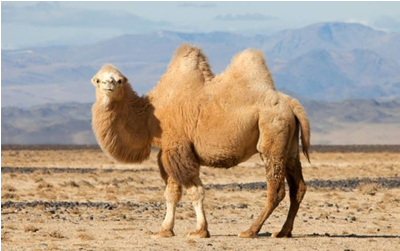 |
|
Name:
Camel  Classification:
Class: Mammalia
Order: Artiodactyla
Family: Camelidae
Tribe: Camelini
Genus: Camelus
Species: 3
Dromedary Camel C. dromedari,
Bactrian Camel
C. bactrianus,
Wild Bactrian Camel C. ferus
Size: Dromedary up
to 7 ft tall, Bactrian 5.5-7ft, Wild Bactrian 6-7.5ft Characteristics:
Tall, four-legged, hoofed, long neck, long snout, large eyes with long
eyelashes and three eyelids on each eye, small, thin tail. Dromedary
has short fur and one fatty hump on its back; Bactrian and Wild Bactrian
have thicker fur including a fluffy mane around the neck, and have two
fatty humps. Status:Dromedary
EXTINCT IN WILD, Common as a domesticated
animal;
Every animal is good at something. Some animals are strong, like bears. Others, like eagles have extremely good eyesight. If you're looking for an animal with high endurance, camels are near the top of the list! Known for the humps on their backs, camels are found across North Africa, the Arabian Peninsula, and central Asia. Most people know there are two kinds of camels: the one-humped camel and the two-humped camel. In fact, there are three species of camel! The dromedary camel (Camelus dromedaries) is the camel with one-hump. As for the two-humped camels, they are divided into two species, the Bactrian camel (Camelus bactrianus) and the wild Bactrian camel (Camelus ferus). The two Bactrian species look similar, but genetically they are very different. The Bactrian camel is taller and has humps twice the size of the wild Bactrian. Camels are built for surviving in harsh conditions. They naturally live in dry deserts and prairies. Camels have tough mouths, which lets them eat just about any plant they come across no matter how thorny it is. Their fur helps them to withstand intense heat and also extreme cold. To protect their eyes from sandstorms, camels have long eyelashes and not one, not two but three eyelids on each eye! Their inner eyelids are transparent, allowing them to see even in storm conditions. There is an old myth about camels storing water in their humps. This is not exactly true. Camels do not store water in their humps. They do store fat in their humps, which is formed from the food they eat and water they drink. A camel can live off a full hump for weeks or travel 100 miles without a single drink! If conditions are right, a camel can live off its hump for months at a time! As the fat is used up, the camel's hump will become floppy until it eats and drinks again. Just because they can go without water for a long time doesn't mean they don't need a lot of water to survive. Camels will drink as much as they can whenever they can. A camel is capable of gulping down about thirty gallons in just ten minutes! Wild Bactrian camels are unique because they are able to drink saltwater. Camels have a slower life cycle than most mammals. Females usually start breeding at three or four years old, and males at about five years old. Males become very aggressive and will fight with other males by attacking their legs. A female camel will carry a calf for as long as thirteen months! After birth, a calf will eventually wean off of its mother's milk. The mother will care for the baby for as long as one-to-two years. Dromedary and Bactrian camels are extinct in the wild. This means that there are no longer any members of their species' living in the wild, but they still exist in captivity. Millions of dromedary and Bactrian camels are used to this day as beasts of burden as well as food. A small population of dromedary camels also exists in Australia, having been imported and then gone feral! The wild Bactrian camel is the last surviving species of wild camel, and this species is critically endangered. There are estimated to be about 1400 wild Bactrian camels left in the world. Their main threat is poaching for their meat. Lack of water sources, habitat destruction, toxic chemicals from illegal mining and cross breeding with Bactrian camels are also major problems. There have even been concerns of radioactive contamination after China experimented with nuclear weapons in the Gobi Desert! Much is being done to save the last wild camels. The Chinese and Mongolian governments have created nature preserves to provide protection. The Wild Camel Protection Foundation is the only non-profit organization dedicated to preserving wild camels and their habitat. The road ahead may be rough, but there is hope that the last wild camels will be able to recover. To learn more about camels and how to protect them, check out these awesome sites! Wild Camel Protection
Foundation-Based in the UK, this is the only organization in the
world that is solely dedicated to protecting wild Bactrian camels! How Stuff Works, "How
long can a camel go without water?"-Here is an in depth look
at how the camel's hump works! |
|
|
|
|
||
|
Contact
Us
|
||||
|
Taproot
Guru © ALL RIGHTS RESERVED
|
||||